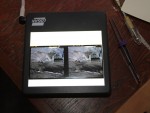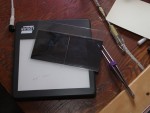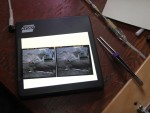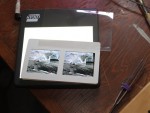Mounting your slides for viewing can be time consuming. When I’m working through a roll of uncut film, I’ll preview the images by cross-eye viewing. The detail isn’t great, but this can give me an idea of which images are worth investing the time required for a precision mount.
Sometimes, however, I want to see the image in a viewer before making my decision. In these cases, I follow a tip from Paul Talbot. I reach for one of my protective sleeves, slip my cut & reversed film chips in, and drop it into my viewer. The images aren’t precisely aligned, but they are often close enough. This technique also lets me try different mount apertures by holding them in front of the image.
If my cross-eye preview of the uncut film finds a promising image, I cut it from the roll. If this still looks like a candidate for mounting, I snip the halves apart and swap them left for right.
- My uncut film
- Cut and swapped
Then I can slip each half into a slide cover. “Alignment” consists of smacking the bottom edge of the sleeve against the table. This settles both image halves at the bottom of the sleeve. It isn’t precise. It doesn’t set the window. It’s just “good enough”.
- Inserted into the sleeve
- “Aligned” for viewing
By dropping the image in a viewer, I can decide if it deserves more time and precision mounting. If so, I select a suitable mount and finish the job.
- Mounted
- Sleeved
If the image isn’t worthy of a mount (or the time required), I’ll usually leave the halves in the sleeve. The next time I’m pawing through my box, I may change my mind and give it a mount.






